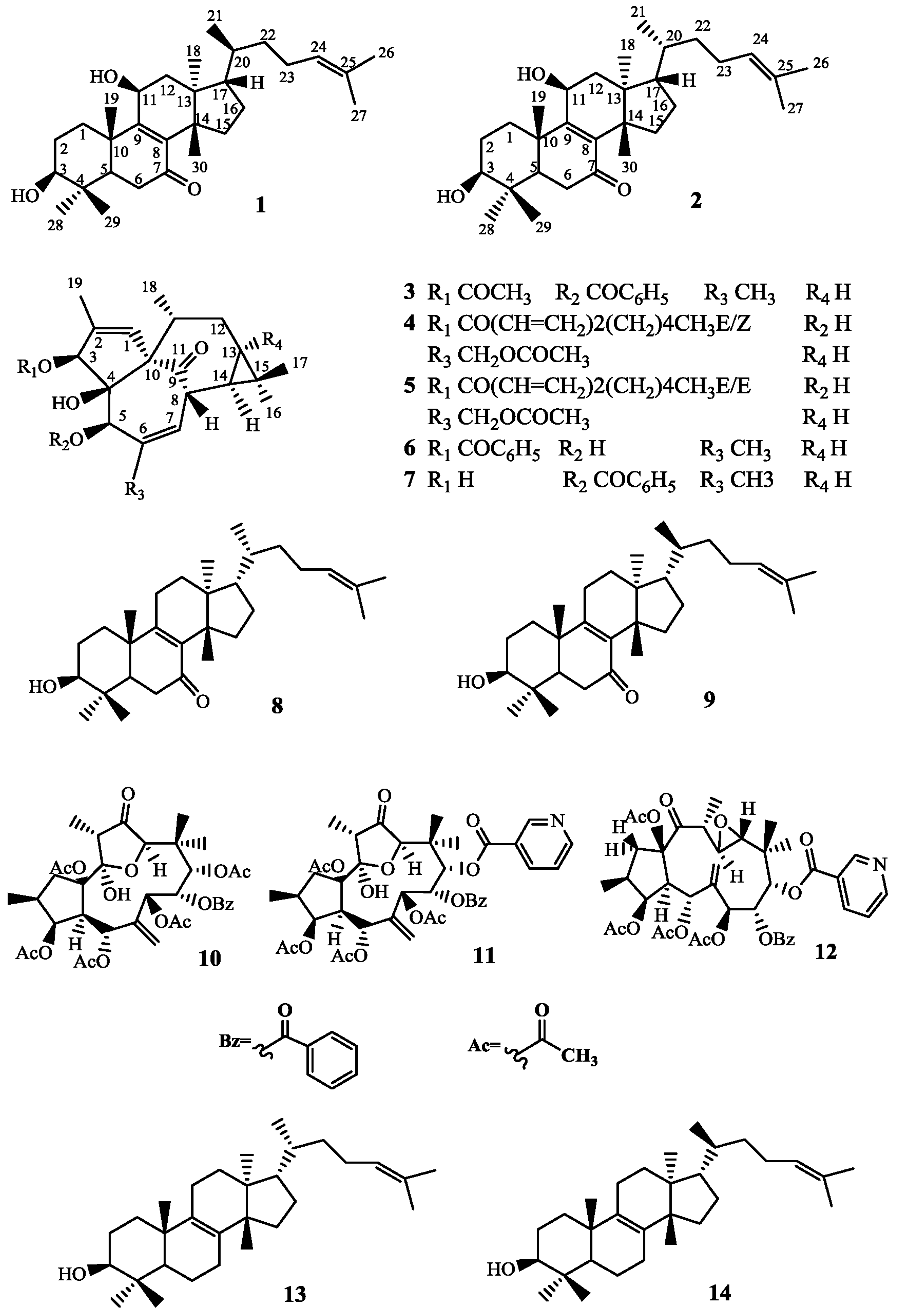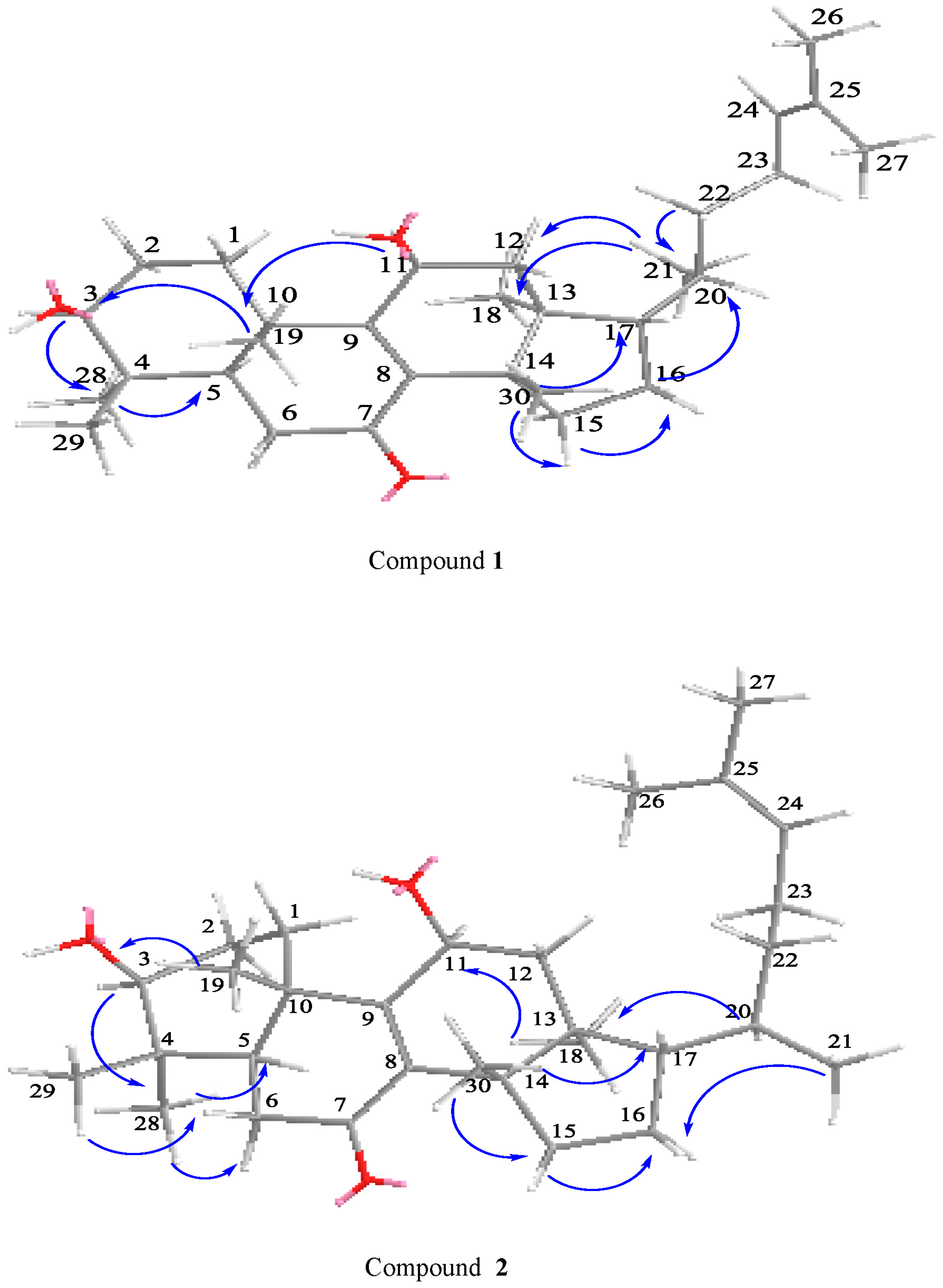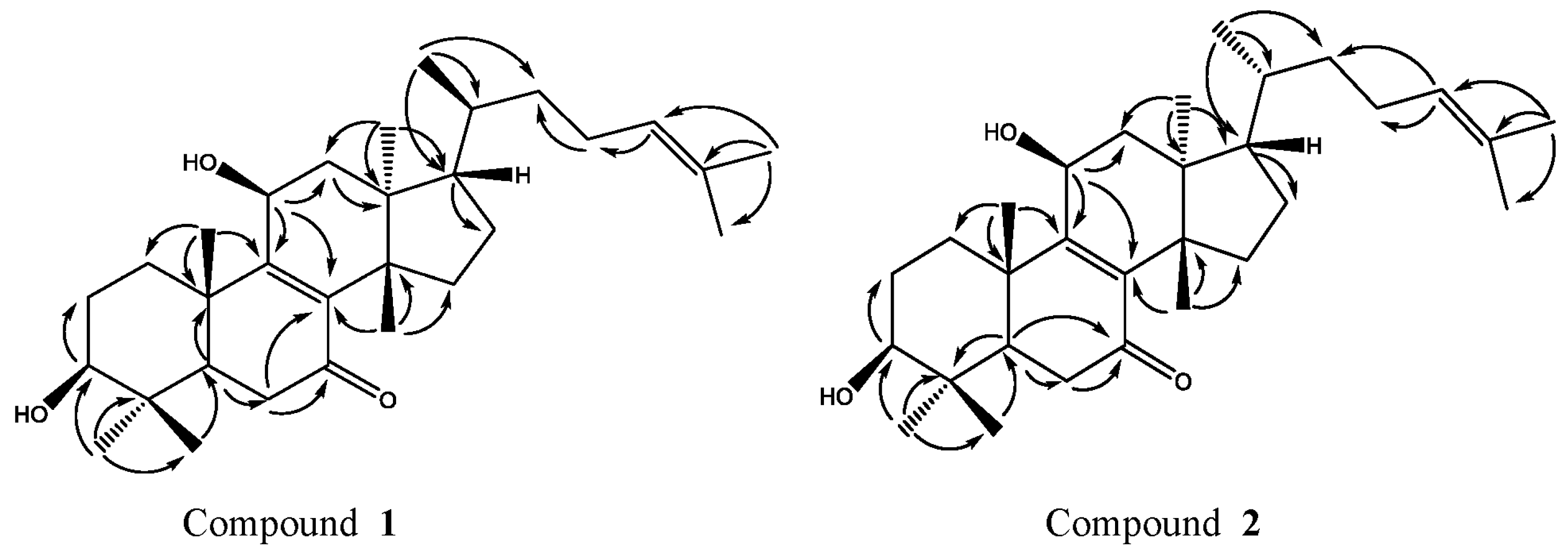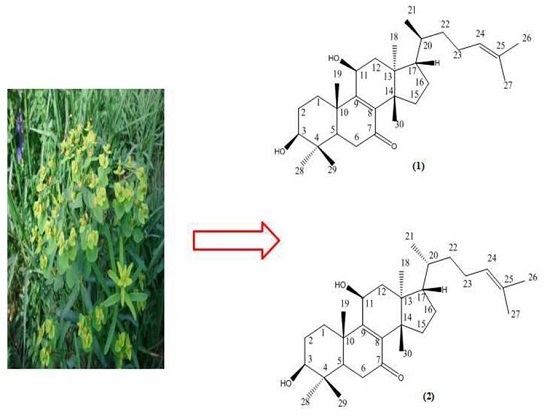Chemical Constituents from Euphorbia kansui
Abstract
:1. Introduction
2. Results and Discussion
3. Materials and Methods
3.1. General Experimental Procedures
3.2. Plant Materials
3.3. Extraction and Isolation
3.4. Cytotoxicity Test
4. Conclusions
Supplementary Materials
Acknowledgments
Author Contributions
Conflicts of Interest
References
- Geng, T.; Huang, H.Y.; Ding, A.W.; Zhang, L. Irritation and diarrhea effect of different polar parts of Euphorbia kansui T. and vinegar-preparing Euphorbia kansui T. Cent. South Pharm. 2008, 6, 385–388. [Google Scholar]
- Wang, L.; Ma, Y.T.; Sun, Q.Y.; Li, X.N.; Yan, Y.; Yang, J.; Yang, F.-M.; Liu, F.-Y.; Zang, Z.; Wu, X.H.; et al. Structurally diversified diterpenoids from Euphorbia dracunculoides. Tetrahedron 2015, 71, 5484–5493. [Google Scholar] [CrossRef]
- Wang, H.; Wang, J.; Luo, J.; Kong, L. Isolation of ingenol-type diterpenoids from Euphorbia kansui by offline coupling of HPLC-ESI-MSn and HSCCC. Sep. Sci. Technol. 2013, 48, 1745–1751. [Google Scholar] [CrossRef]
- Wang, L.Y. The Bioactive Study of Constituents in Kansui. Ph.D. Thesis, Shenyang Pharmaceutical University, Shenyang, China, 2003. [Google Scholar]
- Cheng, F.; Yang, Y.; Zhang, L.; Cao, Y.; Yao, W.; Tang, Y.; Ding, A. A natural triterpene derivative from Euphorbia kansui inhibits cell proliferation and induces apoptosis against rat intestinal epithelioid cell line in vitro. Int. J. Mol. Sci. 2015, 16, 18956–18975. [Google Scholar] [CrossRef] [PubMed]
- Shi, Q.W.; Su, X.H.; Kiyota, H. Chemical and pharmacological research of the plants in genus Euphorbia. Chem. Rev. 2008, 108, 4295–4327. [Google Scholar] [CrossRef] [PubMed]
- Zheng, W.F.; Cui, Z.; Zhu, Q. Cytotoxicity and antiviral activity of the compounds from Euphorbia kansui. Planta Med. 1998, 64, 754–756. [Google Scholar] [CrossRef] [PubMed]
- Li, X.R.; Zhang, Y.D.; Tang, H.H. Study of auxiliary therapeutic effect of kansui root on patients with severe acute pancreatitis. China J. Mod. Med. 2002, 12, 8. [Google Scholar]
- Yan, X.; Zhang, L.; Guo, J.; Cao, Y.; Shang, E.; Tang, Y.; Ding, A.; Duan, J.A. Processing of kansui roots stir-baked with vinegar reduces kansui-induced hepatocyte cytotoxicity by decreasing the contents of toxic terpenoids and regulating the cell apoptosis pathway. Molecules 2014, 19, 7237–7254. [Google Scholar] [CrossRef] [PubMed]
- Wang, L.Y.; Wang, N.L.; Yao, X.S.; Miyata, S.; Kitanaka, S. Euphane and tirucallane triterpenes from the roots of Euphorbia kansui and their in vitro effects on the cell division of Xenopus. J. Nat. Prod. 2003, 66, 630–633. [Google Scholar] [CrossRef] [PubMed]
- Ahmed, E.; Malik, A.; Ferheen, S.; Afza, N.; Lodhi, M.A.; Choudhary, M.I. Chymotrypsin inhibitory triterpenoids from Silybum marianum. Chem. Pharm. Bull. 2006, 54, 103–106. [Google Scholar] [CrossRef] [PubMed]
- Abe, I.; Rohmer, M. Enzymic cyclization of 2,3-dihydrosqualene and squalene 2,3-epoxide by squalene cyclases: From pentacyclic to tetracyclic triterpenes. J. Chem. Soc. Perkin Trans. 1 1994, 7, 783–791. [Google Scholar] [CrossRef]
- Mishra, M.; Shukla, Y.N.; Kumar, S. Euphane triterpenoid and lipid constituents from Butea monosperma. Phytochemistry 2000, 54, 835–838. [Google Scholar] [CrossRef]
- Wang, S.; Liang, H.; Zhao, Y.; Wang, G.; Yao, H.; Kasimu, R.; Wu, Z.; Li, Y.; Huang, J.; Wang, J. New triterpenoids from the latex of Euphorbia resinifera Berg. Fitoterapia 2016, 108, 33–40. [Google Scholar] [CrossRef] [PubMed]
- Akihisa, T.; Yasukawa, K.; Kimura, Y.; Takase, S.I.; Yamanouchi, S.; Tamura, T. Triterpene alcohols from camellia and sasanqua oils and their anti-inflammatory effects. Chem. Pharm. Bull. 1997, 45, 2016–2023. [Google Scholar] [CrossRef] [PubMed]
- Pan, D.-J.; Hu, C.-Q.; Chang, J.-J.; Lee, T.T.-Y.; Chen, Y.-P.; Hsu, H.-Y.; Mcphail, D.R.; Mcphail, A.T.; Lee, K.-H. Kansuiphorin-C and-D, cytotoxic diterpenes from Euphorbia kansui. Phytochemistry 1991, 30, 1018–1020. [Google Scholar]
- Uemura, D.; Hirata, Y.; Chen, Y.P.; Hsu, H.Y. The structure of kansuinine A, a new multi-oxygenated diterpene. Tetrahedron Lett. 1975, 16, 1697–1700. [Google Scholar] [CrossRef]
- Gewali, M.B.; Hattori, M.; Tezuka, Y.; Kikuchi, T.; Namba, T. Constituents of the latex of Euphorbia antiquorum. Phytochemistry 1990, 29, 1625–1628. [Google Scholar] [CrossRef]
- Itoh, T.; Tamura, T.; Matsumoto, T. Tirucalla-7, 24-dienol: A new triterpene alcohol from tea seed oil. Lipids 1976, 11, 434–441. [Google Scholar] [CrossRef]
- Gao, J.; Gao, L.; Zhang, L.; Yao, W.; Cao, Y.; Bao, B.; Ding, A. 3-O-(2′E,4′Z-decadienoyl)-20-O-acetylingenol induces apoptosis in intestinal epithelial cells of rats via mitochondrial pathway. J. Ethnopharmacol. 2015, 174, 331–338. [Google Scholar] [CrossRef] [PubMed]
- Zhang, L.; Gao, L.; Li, Z.; Yan, X.; Yang, Y.; Tang, Y.; Cao, Y.; Ding, A. Bio-guided isolation of the cytotoxic terpenoids from the roots of Euphorbia kansui against human normal cell lines L-O2 and GES-1. Int. J. Mol. Sci. 2012, 13, 11247–11259. [Google Scholar] [CrossRef] [PubMed]
- Shen, J.; Wang, J.; Shang, E.X.; Tang, Y.P.; Kai, J.; Cao, Y.J.; Zhou, G.S.; Tao, W.W.; Kang, A.; Su, S.L.; et al. The dosage-toxicity-efficacy relationship of kansui and licorice in malignant pleural effusion rats based on factor analysis. J. Ethnopharmacol. 2016, 186, 251–256. [Google Scholar] [CrossRef] [PubMed]
- Yan, X.; Zhang, L.; Cao, Y.; Yao, W.; Tang, Y.; Ding, A. An Ingenol Derived from Euphorbia kansui Induces Hepatocyte Cytotoxicity by Triggering G0/G1 Cell Cycle Arrest and Regulating the Mitochondrial Apoptosis Pathway in Vitro. Molecules 2016, 21, 813. [Google Scholar] [CrossRef] [PubMed]
Sample Availability: Not available. |



| Position | Compound 1 | Compound 2 |
|---|---|---|
| 1α | 1.56–1.62 (m) | 1.52–1.60 (m) |
| 1β | 2.41–2.47 (m) | 2.40–2.46 (m) |
| 2 | 1.70–1.79 (m) | 1.70–1.79 (m) |
| 3α | 3.31 (dd, J = 6.4, 9.6) | 3.31 (dd, J = 6.4, 9.6) |
| 5 | 1.65–1.68 (m) | 1.62–1.68 (m) |
| 6 | 2.40–2.47 (m) | 2.40–2.48 (m) |
| 11 | 4.70 (t, J = 8.2) | 4.69 (t, J = 8.2) |
| 12α | 1.76–1.81 (m) | 1.74–1.81 (m) |
| 12β | 2.38–2.46 (m) | 2.35–2.43 (m) |
| 15α | 2.10–2.12 (m) | 2.12–2.19 (m) |
| 15β | 1.42–1.46 (m) | 1.40–1.46 (m) |
| 16α | 1.93–1.99 (m) | 1.90–1.94 (m) |
| 16β | 1.28–1.33 (m) | 1.28–1.32 (m) |
| 17 | 1.54–1.61 (m) | 1.55–1.60 (m) |
| 18 | 0.71 (s) | 0.73 (s) |
| 19 | 1.28 (s) | 1.27 (s) |
| 20 | 1.40–1.47 (m) | 1.40–1.46 (m) |
| 21 | 0.94 (d, J = 6.6) | 0.88 (d, J = 6.4) |
| 22 | 1.03–1.12 (m) | 1.08–1.13 (m) 1.56–1.62 (m) |
| 23 | 1.83–1.91 (m) 2.01–2.08 (m) | 1.84–1.90 (m) 1.98–2.02 (m) |
| 24 | 5.09(t, J = 7.2) | 5.09 (t, J = 7.2) |
| 26 | 1.70 (s) | 1.70 (s) |
| 27 | 1.62 (s) | 1.63 (s) |
| 28 | 1.00 (s) | 1.01 (s) |
| 29 | 0.92 (s) | 0.93 (s) |
| 30 | 1.15 (s) | 1.16 (s) |
| Position | Compound 1 | Compound 2 |
|---|---|---|
| 1 | 33.68 | 33.67 |
| 2 | 27.37 | 27.36 |
| 3 | 78.27 | 78.26 |
| 4 | 39.07 | 39.06 |
| 5 | 49.25 | 49.25 |
| 6 | 35.84 | 35.84 |
| 7 | 200.10 | 200.16 |
| 8 | 140.46 | 140.44 |
| 9 | 161.25 | 161.30 |
| 10 | 39.58 | 39.58 |
| 11 | 68.11 | 68.11 |
| 12 | 42.79 | 42.83 |
| 13 | 46.19 | 46.19 |
| 14 | 47.95 | 48.02 |
| 15 | 31.88 | 31.81 |
| 16 | 27.77 | 27.80 |
| 17 | 49.13 | 48.69 |
| 18 | 16.06 | 16.24 |
| 19 | 19.70 | 19.67 |
| 20 | 36.03 | 35.61 |
| 21 | 18.68 | 18.76 |
| 22 | 36.24 | 35.51 |
| 23 | 24.86 | 24.82 |
| 24 | 124.98 | 124.90 |
| 25 | 131.09 | 131.14 |
| 26 | 25.68 | 25.73 |
| 27 | 17.62 | 17.70 |
| 28 | 27.59 | 27.59 |
| 29 | 15.18 | 15.19 |
| 30 | 25.62 | 25.70 |
| Compound | IC50 (μΜ) | ||
|---|---|---|---|
| HCT-116 | MKN-45 | MCF-7 | |
| 1 | 20.84 ± 1.28 | 10.18 ± 1.36 | 10.82 ± 1.18 |
| 2 | 33.97 ± 2.15 | 14.95 ± 1.82 | 20.11 ± 2.16 |
| Cisplatin | 8.465 ± 0.84 | 6.142 ± 1.12 | 9.035 ± 0.92 |
| 5-Fu | 6.172 ± 2.03 | 2.624 ± 2.06 | 1.629 ± 1.42 |
| Compound | IC50 (μΜ) | |
|---|---|---|
| L-O2 | GES-1 | |
| 1 | 56.98 ± 1.74 | 40.99 ± 0.85 |
| 2 | 49.89 ± 2.12 | 40.27 ± 1.28 |
| Position | Compound 8 | Compound 9 | Compound 13 | Compound 14 |
|---|---|---|---|---|
| 1 | 34.61 | 34.61 | 35.26 | 35.26 |
| 2 | 27.40 | 27.41 | 27.95 | 27.92 |
| 3 | 78.07 | 78.06 | 79.00 | 79.03 |
| 4 | 38.82 | 38.83 | 38.94 | 38.94 |
| 5 | 48.19 | 48.24 | 50.97 | 50.97 |
| 6 | 35.77 | 35.78 | 18.95 | 18.95 |
| 7 | 198.37 | 198.35 | 27.68 | 27.67 |
| 8 | 138.94 | 138.93 | 134.03 | 134.08 |
| 9 | 165.46 | 165.48 | 133.55 | 133.51 |
| 10 | 39.27 | 39.27 | 37.24 | 37.27 |
| 11 | 23.73 | 23.67 | 21.53 | 21.45 |
| 12 | 29.95 | 29.87 | 30.90 | 30.80 |
| 13 | 44.62 | 44.61 | 44.12 | 44.11 |
| 14 | 47.68 | 47.61 | 50.03 | 50.12 |
| 15 | 31.39 | 31.45 | 29.77 | 28.83 |
| 16 | 28.67 | 28.65 | 28.14 | 28.05 |
| 17 | 48.24 | 48.76 | 49.64 | 49.96 |
| 18 | 15.73 | 15.54 | 15.63 | 15.52 |
| 19 | 18.60 | 18.61 | 20.15 | 20.14 |
| 20 | 35.65 | 36.16 | 35.88 | 36.33 |
| 21 | 18.90 | 18.75 | 18.92 | 18.69 |
| 22 | 35.52 | 36.35 | 35.43 | 36.40 |
| 23 | 24.74 | 24.91 | 24.77 | 24.94 |
| 24 | 125.07 | 125.12 | 125.22 | 125.26 |
| 25 | 131.04 | 131.01 | 130.08 | 130.90 |
| 26 | 25.76 | 25.73 | 17.69 | 17.62 |
| 27 | 17.71 | 17.65 | 25.74 | 25.71 |
| 28 | 27.28 | 27.29 | 27.92 | 27.92 |
| 29 | 15.07 | 15.07 | 15.53 | 15.43 |
| 30 | 24.42 | 24.31 | 24.47 | 24.36 |
© 2017 by the authors. Licensee MDPI, Basel, Switzerland. This article is an open access article distributed under the terms and conditions of the Creative Commons Attribution (CC BY) license (http://creativecommons.org/licenses/by/4.0/).
Share and Cite
Zhang, Q.; Zhou, Q.-R.; Lou, J.-W.; Chen, P.-D.; Yao, W.-F.; Tao, W.-W.; Tang, Y.-P.; Dai, G.-C.; Wang, K.; Zhang, L. Chemical Constituents from Euphorbia kansui. Molecules 2017, 22, 2176. https://doi.org/10.3390/molecules22122176
Zhang Q, Zhou Q-R, Lou J-W, Chen P-D, Yao W-F, Tao W-W, Tang Y-P, Dai G-C, Wang K, Zhang L. Chemical Constituents from Euphorbia kansui. Molecules. 2017; 22(12):2176. https://doi.org/10.3390/molecules22122176
Chicago/Turabian StyleZhang, Qiao, Qin-Rong Zhou, Jian-Wei Lou, Pei-Dong Chen, Wei-Feng Yao, Wei-Wei Tao, Yu-Ping Tang, Guan-Cheng Dai, Kun Wang, and Li Zhang. 2017. "Chemical Constituents from Euphorbia kansui" Molecules 22, no. 12: 2176. https://doi.org/10.3390/molecules22122176






